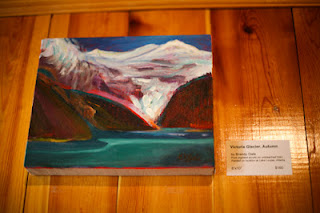From Single Malt Cove | by Brandy Gale | Wellington Times
Reading aloud
“Truly fine poetry must be read aloud. A good poem does not allow itself to be read in a low voice or silently. If we can read it silently, it is not a valid poem: a poem demands pronunciation. Poetry always remembers that it was an oral art before it was a written art. It remembers that it was first song.” - Jorge Luis BorgesWhile I was in early recovery from my recent eye surgery, a gentleman friend read aloud to me from You Know What is Right, a book of short stories by Jim Heynen. (1985, North Point Press, San Francisco.) We were at the beach. Closing my eyes, I listened to his voice against a backdrop of waves lapping the shore and felt the sun on my body. Months later, I am still surprised at how much the intimate connection we now share is enhanced when I recall that activity. Can you recall the last time you were read aloud to on a date?
 |
| HK reading to me, Prince Edward County |
“Reading aloud to each other” was a common activity in the 1800s and early 1900s, particularly among couples. But it is seemingly rare today for adults to read to one another. Our ears and eyes are so inundated with the clamour emanating from TV, radio, cell phones, computers and mall media that most of us couldn’t hear the sound of one voice quietly reading if our lives depended on it. And, anyway, who has the time to listen?
Of course, audio books have allowed us to be read to. Hearing well-written words read by another person can really bring them to life. But we do not engage with the orator of an audio book. Trapped between our ear buds, it is an isolating experience.
We all know that reading aloud to children helps build imagination, listening skills, and comprehension, and is an effective bonding process. But what of adults reading to one another in person? Are there benefits?
Listening to those reading aloud can improve your concentration, something likely not served well by social media’s 140-character-maximum Twitterverse, and sound byte spoonfuls of ticker tape news on television.
Suzanne Bishop, author at www.beatingdyslexia.com explains, “Reading out loud has helped me develop control, timing and focus of attention. At the same time I’ve developed natural reading rhythm. However by far the most important factor is the confidence reading in front of other people has given me. It’s made me feel like I’ve beaten dyslexia.”
In a 2005 study in Japan, researchers found that reading aloud evidenced a statistically significant improvement in the brain function of people with dementia. (J Gerontol A Biol Sci Med Sci. 2005 Mar;60(3):380-4.)
And Richard Nordquist, PhD professor emeritus of rhetoric and English at Armstrong Atlantic State University, suggests we read aloud to savour the prose of the great writers. He cites rhetorician Richard Lanham, “who advocates reading good prose out loud as ‘a daily practice’ to counter the ‘bureaucratic, unvoiced, asocial official style’ that anesthetizes so many of us in the workplace.”
Nordquist also points out that reading silently to oneself was not always the norm. “Back in the fourth century, tongues started wagging when Augustine of Hippo walked in on Ambrose, the bishop of Milan, and found him . . . reading to himself!”
Among my best memories are of my Dad reading aloud to us. He still reads aloud to me from the newspaper when I am visiting. Yes, a real live newspaper. Why not read the Times columns aloud to your family? Or invite friends over and make reading aloud part of a social gathering?
In a world where we text one another from the next room, making time to read aloud to one another might even help re-balance a potentially escalating lack of personal connection.
First published in The Wellington Times
September, 2012
Read article here.





















